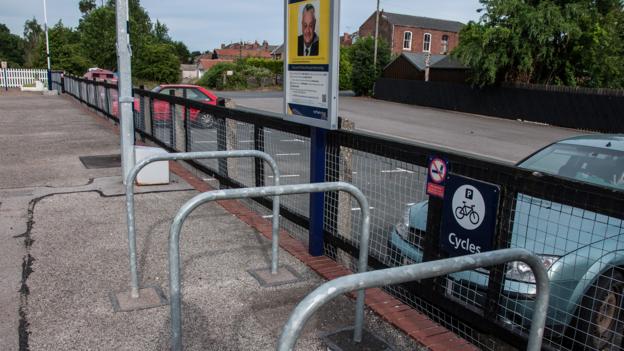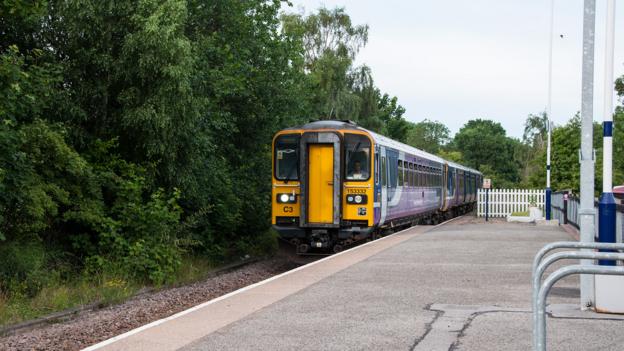Why Britain has Secret Ghost Trains

Empty
and all but unknown, ghost trains are one of British transport’s
strangest quirks. Why do they exist? To find out, Amanda Ruggeri gets on
board.
23 July 2015
The train that cuts across the West Yorkshire countryside from Leeds to the small town of Snaith departs just once at precisely 17:16, Monday to Saturday. Return trains depart twice: one at 07:16, one at 19:01.
Given these infrequent departures, you’d expect packed carriages. But on a recent Friday rush hour – when Leeds train station, the second-busiest in the UK outside London, is swirling with commuters – no one, aside from me and my companions, remains on the line for more than a few stops. Soon, one carriage after another becomes completely, eerily empty. You could cartwheel down the aisles.

One empty seat after another (Credit: Amanda Ruggeri)
BA On Background British Airways Brand
Spending for international business travel is set to hit a record high of US$1.25 trillion this year. And the shrewdest of the jet-setters will make sure that they're making the most out of these experiences.
Whether you're a skeleton start-up, thriving SME, or established corporate company, signing up to a loyalty programme is well worth your while.
Click here to discover more about British Airways' new business loyalty programme, that's not only free to join, but offers the chance to earn points and enjoy discounts on British Airways, American Airlines and Iberia flights.
The Leeds-Snaith line is what rail enthusiasts call a ghost train; Snaith station, a ghost station. The webpage about Snaith on ticket sales site TheTrainLine.com warns that ticket machines are not available at the station. Nor is there a ticket office, taxi rank or cab office.
It’s one of many train services around Britain that run with empty carriages – sometimes once or twice a day, sometimes as rarely as once a week. Sometimes even ticket sellers don’t know they exist, and it takes dedicated amateurs to seek them out. So why do these trains run at all?
The whisper of a service
There is no single definition of what constitutes a ghost train, although the general consensus is that it’s when a service is so infrequent, the train becomes effectively useless. Slippery or not, though, the term “ghost train” seems apt. It implies a service that is not exactly whole – something that whispers through towns and countryside, leaving barely a dent in its wake.
Only a special few even know that ghost trains exist
Perhaps most important of all, the term ghost train implies something that only a special few know exists. The press contact of the National Rail Museum of York, for example, was baffled by my request for an interview about ghost trains, thinking I wanted to discuss “haunted items” in the museum’s collection.
Nobody knows exactly how many ghost trains there are. On the website The Ghost Station Hunters, run by rail enthusiasts Tim Hall-Smith and Liz Moralee, there are 37 listed, and those are only the stations the intrepid pair has gotten to and written about so far. Hall-Smith says he’s counted more than 50 by looking through timetables.

The near-empty car park, and bicycle racks, of the Snaith train station (Credit: Amanda Ruggeri)
Official figures are difficult to track down. Northern Rail, which runs the Leeds to Snaith line, said they have six such trains; that’s out of 2,500 services they run each day. But a request from the Department of Transport for overall numbers turned up nil: “The department doesn’t hold a definitive list of these low-frequency routes, because we don’t use the terminology of ghost train – there’s no formally agreed definition of what would constitute one,” says Andrew Scott, one of the Department of Transport’s press officers.
Chasing trains
The sheer mystery of ghost trains is part of what makes them compelling to a small, but passionate, community of “ghost train hunters” that, Hall-Smith and Moralee say, spans the globe, sharing information online through websites like theirs. Hall-Smith has been chasing the trains since 1993, visiting 41 ghost stations. Moralee has visited 32. They take pictures at each one and try to put them on their website, with detailed descriptions about how to get there and what to expect. To celebrate his 50th birthday, they went to Berney Arms in Norfolk. “It has to be one of the maddest places we have both been to,” he says. “No words can describe how isolated this place was.” The closest road was three miles away; the only nearby structures were a shuttered pub and an old windmill.
It’s a passion that takes commitment. Since the trains are run on extremely inconvenient schedules, sometimes without a return trip, sometimes before sunrise, the journey means a lot of legwork. If there is anyone else on the train, it’s probably another ghost train enthusiast.
It’s a useless, limited service. But there would be a stink if anyone tried to close it
Given the overcrowding on Britain’s trains, it may seem odd for these empty carriages to ride the rails – or for empty stations to stand sentry over them. From 1995-96 to 2011-12, the total number of miles ridden by train passengers leapt by 91%, while the entire UK train fleet grew by only 12%.
“Ghost trains are there just for a legal placeholder to prevent the line from being closed,” says Bruce Williamson, national spokesperson for the advocacy group RailFuture. Or as Colin Divall, professor of railway studies at the University of York, puts it: “It’s a useless, limited service that’s borderline, and the reason that it’s been kept is there would be a stink if anyone tried to close it.”
Why ghosts exist
That is the crux of why the ghost trains still exist. A more official term is “parliamentary trains”, a name that stems from past years when an Act of Parliament was needed to shut down a line. Many train operators kept running empty trains to avoid the costs and political fallout – and while this law has since changed, the same pressures remain.
Closing down a line is cumbersome. There must first be a transport appraisal analysing the effect of a closure on passengers, the environment and the economy. The proposal is submitted to the Department of Transport and at that point its details must be published in the press, six months ahead of the closure. Then comes a 12-week consultation period, during which time anyone is welcome to protest; public hearings are sometimes held, especially if the closure is controversial. Then, finally, the plans are submitted to the Office of Rail and Road, who decide if the line closes.
As a result it often costs less – in terms of time, paperwork and taxpayers’ money – to keep a line running at a bare minimum. Other nations run limited service trains, but experts say that the particular politicisation of Britain’s railways – and the creation of so many steps required to close them – means that when people say “ghost trains,” they’re usually referring to British ones.

A 'ghost train' pulls into Snaith's station (Credit: Amanda Ruggeri)
There’s a more optimistic reason for running a ghost train, too: it shows hope that the line may be used more regularly again in the future. Once a service is closed entirely, infrastructure deteriorates; even if the physical track is kept, it becomes overgrown. Not to mention that drivers then would have to be re-trained on the track, or that a whole new slew of paperwork would have to be gone through to re-open it. Starting from scratch, in other words, is far more expensive than maintaining what you have.
Some ghost services have come back from the dead
The Halton Curve is one example. A half-mile connection between two lines that are frequently serviced, it operated for years as a ghost train. After years of advocates defending its potential, if run more regularly, to provide service from North Wales into Liverpool, plans were finally announced last year to give it a £10.4 million upgrade and re-establish the link, returning it to full service.
Experts say that Halton Curve is emblematic of an ongoing trend. Closing lines is particularly rare these days. It’s far more common to see new lines opening or limited service lines being returned to full service. Ghost trains, in other words, may be at risk.
That’s good news for railway advocates who want to see the country better connected by more efficient, frequently running trains. But it may be bad news to those like Hall-Smith and Moralee, who have built a lifelong passion out of tracking the ghosts down.
There is no train to Snaith
On our ride to Snaith, the two tell me about the trouble Moralee had procuring her ticket. The Snaith train was listed on the board of departures, but the person at the ticket desk still hadn’t heard of it. “You must be mistaken,” he’d told her. “There is no train to Snaith.”
“That’s what we love about this,” Hall-Smith says: knowing a secret that, in the hyper-organised and planned world of rail transport, shouldn’t exist. A secret that not even everyone who works in that world knows exists.
A ghost train might be a bureaucratic hangover. It might be a fiscal headache. It might be a waste of resources and potential. But in the world of transport and infrastructure, where efficiency and budgets rule, it’s also a quirky aberration – one that might not be around forever, but that, for now, provides an acute sense of joy to a small, passionate group of people who love it for its Alice-in-Wonderland-style absurdity.
http://www.bbc.com/future/story/20150723-why-britain-has-secret-ghost-trains



No comments:
Post a Comment